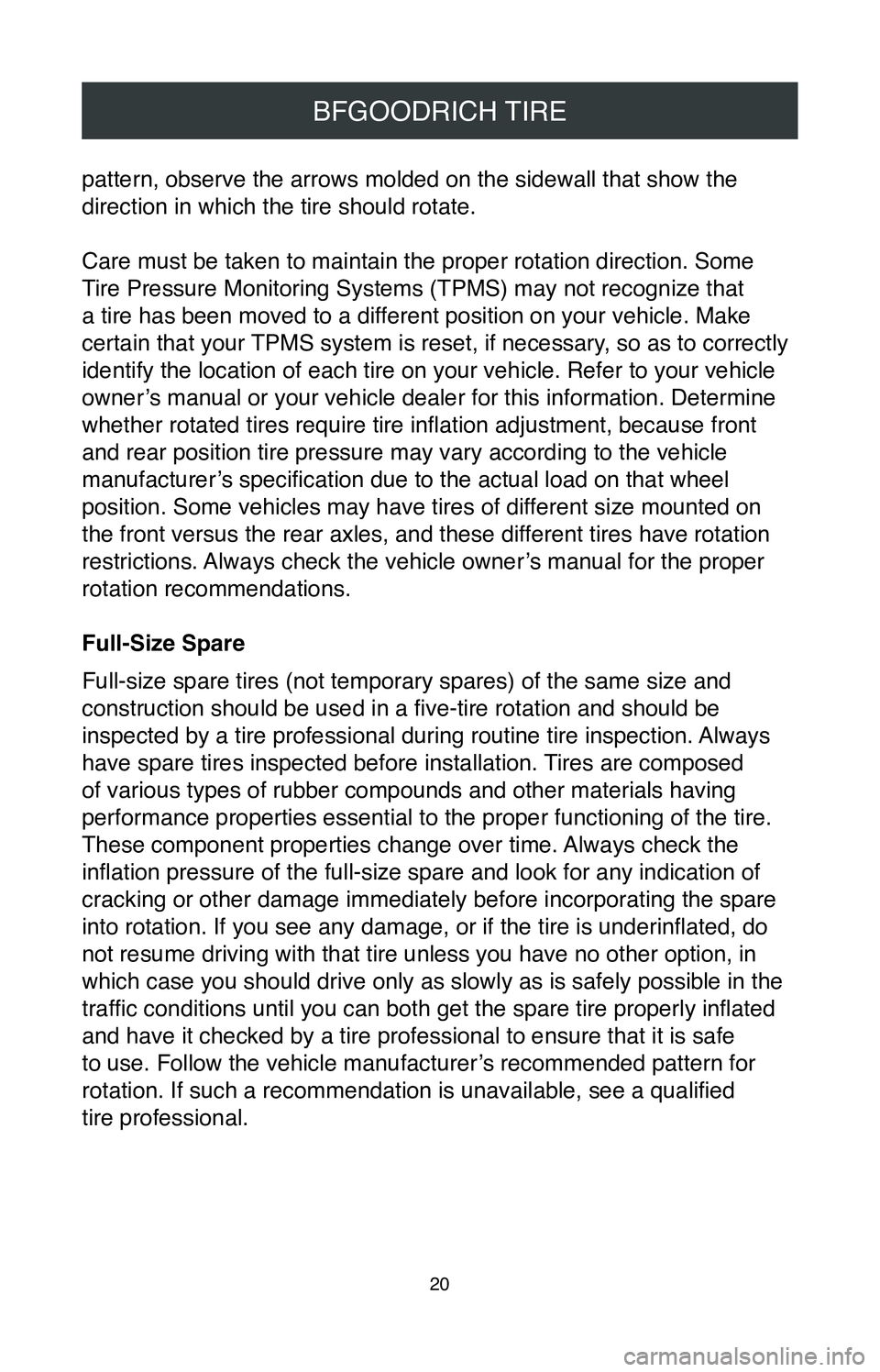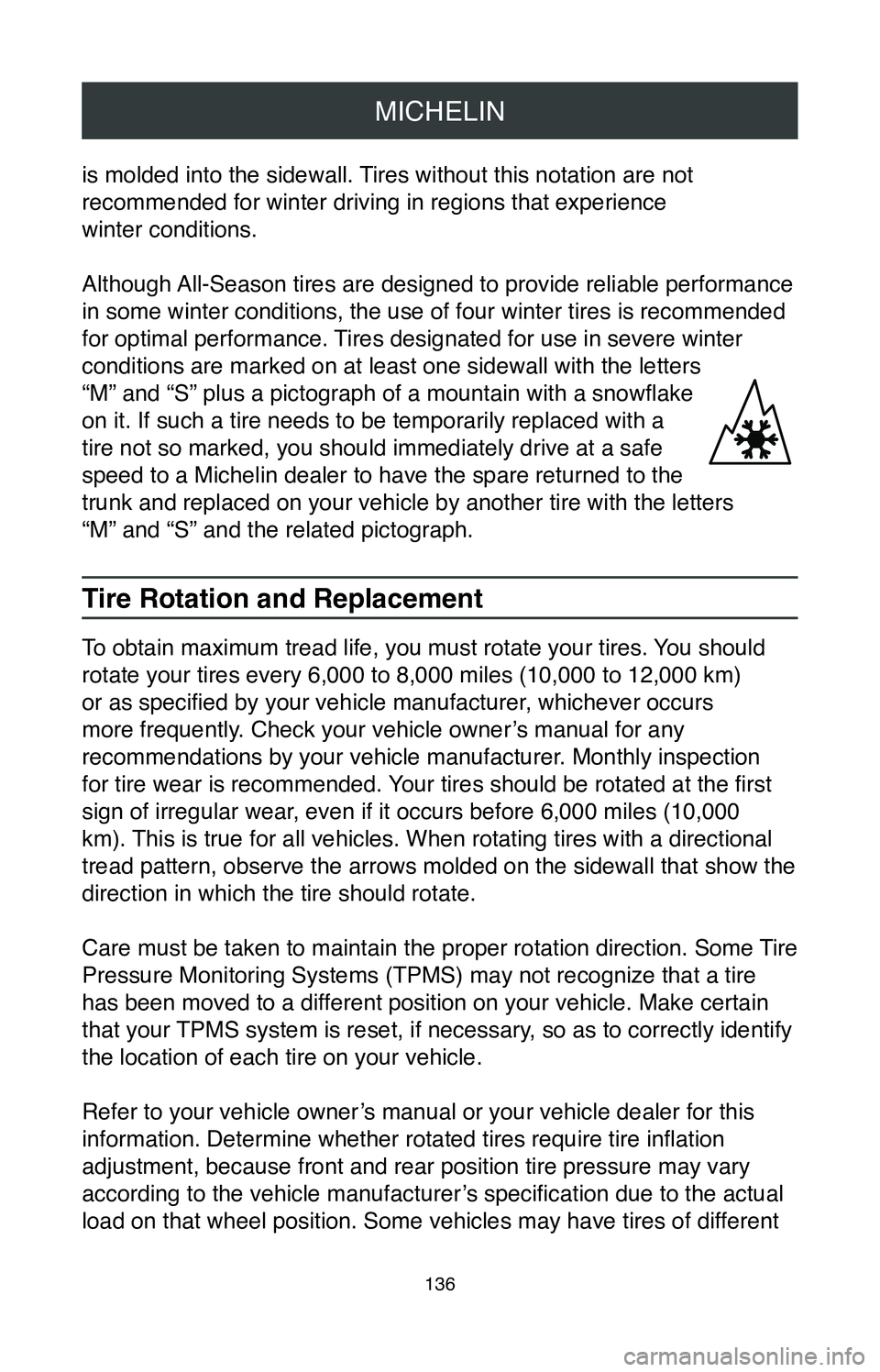reset TOYOTA HIGHLANDER HYBRID 2020 Warranties & Maintenance Guides (in English)
[x] Cancel search | Manufacturer: TOYOTA, Model Year: 2020, Model line: HIGHLANDER HYBRID, Model: TOYOTA HIGHLANDER HYBRID 2020Pages: 260, PDF Size: 8.54 MB
Page 22 of 260

20
BFGOODRICH TIRE
pattern, observe the arrows molded on the sidewall that show the
direction in which the tire should rotate.
Care must be taken to maintain the proper rotation direction. Some
Tire Pressure Monitoring Systems (TPMS) may not recognize that
a tire has been moved to a different position on your vehicle. Make
certain that your TPMS system is reset, if necessary, so as to correctly
identify the location of each tire on your vehicle. Refer to your vehicl\
e
owner’s manual or your vehicle dealer for this information. Determine
whether rotated tires require tire inflation adjustment, because front
and rear position tire pressure may vary according to the vehicle
manufacturer’s specification due to the actual load on that wheel
position. Some vehicles may have tires of different size mounted on
the front versus the rear axles, and these different tires have rotation
restrictions. Always check the vehicle owner’s manual for the proper
rotation recommendations.
Full-Size Spare
Full-size spare tires (not temporary spares) of the same size and
construction should be used in a five-tire rotation and should be
inspected by a tire professional during routine tire inspection. Always
have spare tires inspected before installation. Tires are composed
of various types of rubber compounds and other materials having
performance properties essential to the proper functioning of the tire. \
These component properties change over time. Always check the
inflation pressure of the full-size spare and look for any indication of
cracking or other damage immediately before incorporating the spare
into rotation. If you see any damage, or if the tire is underinflated, do
not resume driving with that tire unless you have no other option, in
which case you should drive only as slowly as is safely possible in the \
traffic conditions until you can both get the spare tire properly inflated
and have it checked by a tire professional to ensure that it is safe
to use. Follow the vehicle manufacturer’s recommended pattern for
rotation. If such a recommendation is unavailable, see a qualified
tire professional.
Page 138 of 260

MICHELIN
136
is molded into the sidewall. Tires without this notation are not
recommended for winter driving in regions that experience
winter conditions.
Although All-Season tires are designed to provide reliable performance
in some winter conditions, the use of four winter tires is recommended
for optimal performance. Tires designated for use in severe winter
conditions are marked on at least one sidewall with the letters
“M” and “S” plus a pictograph of a mountain with a snowflake
on it. If such a tire needs to be temporarily replaced with a
tire not so marked, you should immediately drive at a safe
speed to a Michelin dealer to have the spare returned to the
trunk and replaced on your vehicle by another tire with the letters
“M” and “S” and the related pictograph.
Tire Rotation and Replacement
To obtain maximum tread life, you must rotate your tires. You should
rotate your tires every 6,000 to 8,000 miles (10,000 to 12,000 km)
or as specified by your vehicle manufacturer, whichever occurs
more frequently. Check your vehicle owner’s manual for any
recommendations by your vehicle manufacturer. Monthly inspection
for tire wear is recommended. Your tires should be rotated at the first
sign of irregular wear, even if it occurs before 6,000 miles (10,000
km). This is true for all vehicles. When rotating tires with a directional
tread pattern, observe the arrows molded on the sidewall that show the
direction in which the tire should rotate.
Care must be taken to maintain the proper rotation direction. Some Tire
Pressure Monitoring Systems (TPMS) may not recognize that a tire
has been moved to a different position on your vehicle. Make certain
that your TPMS system is reset, if necessary, so as to correctly identify
the location of each tire on your vehicle.
Refer to your vehicle owner’s manual or your vehicle dealer for this
information. Determine whether rotated tires require tire inflation
adjustment, because front and rear position tire pressure may vary
according to the vehicle manufacturer’s specification due to the actual
load on that wheel position. Some vehicles may have tires of different